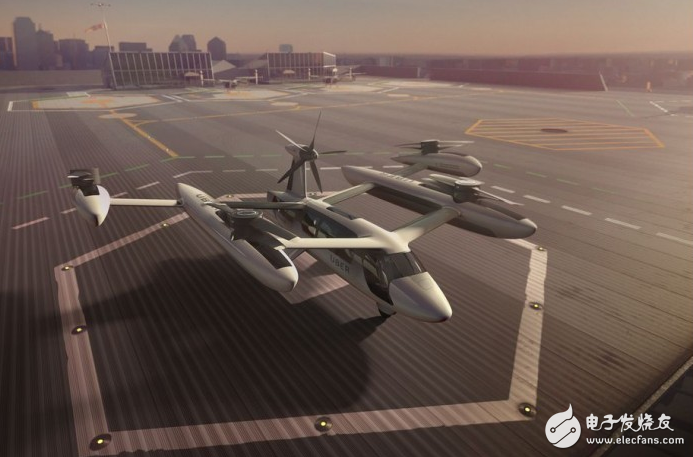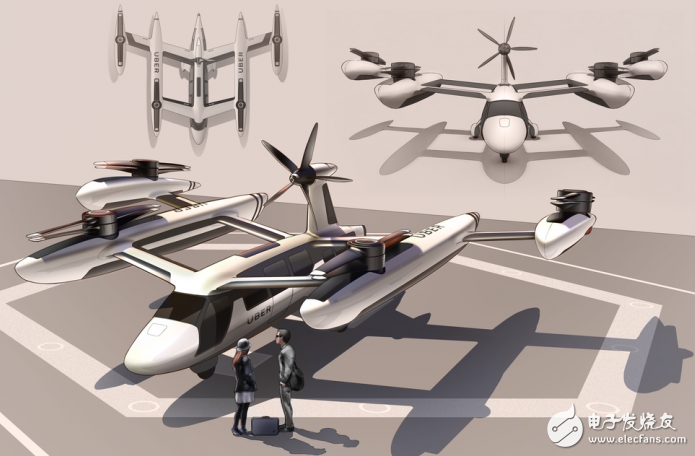Humans have never stopped exploring more efficient travel methods. Next, competition in the transportation field may be in the sky.

Last month, Uber acquired Jump Bikes, a U.S. pileless shared motorcycle platform. After the acquisition, Uber's business includes online car-hailing, subway, and bicycle services. It's not enough to only lay out the traffic on land. This time, Uber aimed the sky.
This morning, Uber announced that it has reached a cooperation with aircraft manufacturer Karem to jointly develop an electric vertical take-off and landing device, create an airless driverless electric vehicle, and deploy air traffic services. Prior to this, Uber has reached cooperation with aircraft manufacturers Embraer and Pipistrel Aircraft, self-developed aviation system company Aurora Flight Sciences, helicopter company Bell and so on.

The "flying car" developed by Uber is a hybrid of helicopters and ordinary aircraft, which can take off and land vertically without runway approach. The primary consideration for traffic travel is safety. This "flying car" has four symmetrical horizontal rotors, and a rotor at the tail to provide thrust. Even if one rotor is broken, the other rotors can guarantee it to land safely.
Long-distance commuting is a common problem in large cities. Take the United States as an example. In 2017, the average commuting time per person in San Francisco was 230 hours, which is not only a physical expenditure; according to a study in the American Journal of Preventive Medicine, people who commute more than 10 miles will increase their blood pressure. probability. Uber "flying cars" want to increase the efficiency of long-distance travel, save commuting time, and reduce energy waste.
Travel cost is the most concern of users. Uber cuts costs as much as possible in every aspect of design and production: In this "flying car" design, Uber replaces the traditional gas-powered engine by installing 8-10 small electric motors around the aircraft, by changing the airflow, Improve the efficiency of the motor; in production, Uber believes that the first batch can produce thousands of flying equipment based on the judgment of the market, this mass production can effectively reduce production costs; In addition, the flying car is powered by electricity, which can reduce fuel and The cost of maintenance. As a result, the travel cost per passenger per mile can be as low as $ 5.73.
Uber's "flying car" will be commercially tested in Dallas and Los Angeles in 2020, and is scheduled to be officially commercialized in Dallas, Frisco, Texas, and Los Angeles in 2023, with four people per ride.

Humans have never stopped exploring more efficient ways to travel: the subway resolves the pressure of ground traffic congestion, and the underground tunnel Musk is digging can shorten the drive from Washington to New York to 29 minutes; this time Uber wants to do "Car" tried to solve the problem of remote commuting from a new perspective.
Coincidentally, in addition to Uber, the flying car Cora invested by Google CEO Larry Page will be put into trial operation in 2021; German startup Volocopter is building an "air taxi" system; China is also developing aerial car projects Ehang 184 and Terrafugia. Future competition in the field of transportation may be in the sky.
1200V DC Electronic Load System
1200V DC Electronic Load System has battery discharge function, and can perform discharge test under CC, CR or CP mode. The DC load can set end voltage or time to stop loading correctly and make sure the battery is not damaged due to over discharge. The user can set stop conditions, whenever met any condition, the load will stop loading and counting automatically. During the test, users can observe battery's voltage, discharging time and already-discharged-capacity.1200V DC Electronic Load system including 39600W/52800W/66000W.BTW,if the 1200V is too big voltage for application,it can also choose lower 200V DC Electronic Load System and higher 1200V DC Electronic Load System .
kindly check below features are for your reference:
â— Flippable front panel and color touch screen allow convenient access and operation
â— Provides four kinds of basic working mode such as CV/CC/CR/CP, and CV+CC/CV+CR/CR+CC complex operating modes
â— Adjustable current slew rate, adjustable CV loop speed
â— Ultra high precision voltage & current measurement
â— OCP/OPP testing function
â— 50kHz high-speed CC/CR dynamic mode
â— 500kHz high-speed voltage and current sampling rate
â— Timing & discharging measurement for batteries
â— Short circuit test mode
â— Auto mode function provides an easy way to do complicated test
â— Dynamic frequency sweep function for determining worst case voltage peaks*
â— Non linear load mode function makes the simulated loading current more realistic*
â— Supports external analog control function*
â— V-monitor/I-monitor
â— LED load simulation function
â— Full protection: OCP, OPP, OTP, over voltage and reverse alarm
â— Up to 20 units master/slave parallel control
â— Front panel USB interface supports data import and export
â— SCPI language and standard rack size make it ideal for ATE System integration
â— Smart fan control with lower noise and better for environment
â— Multi versions to meet the cost performance and different applications
* Only professional Electronic Load units support these functions
1200V Battery Discharge DC E-load, 1200V Short circuit DC electronic load, 120V IV-monitor DC electronic load
APM Technologies Ltd , https://www.apmpowersupply.com